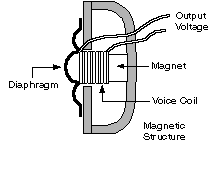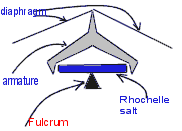How microphones work
Carbon Microphones.
Up until the mid 1930's, most microphones were made out of a capsule of compressed carbon powder. Carbon mics worked because the sound energy vibrated the carbon particles pushing them together and making the capsule a better or worse conductor of electricity. By forcing a small current through the carbon, the electric flow could be broken up by the effect of sound on the carbon. Carbon microphones were cheap and durable. They were in all early telephones. Their problem was that they did not have a very good frequency response. The carbon particles did not respond well to higher frequencies, and the low notes did not have enough energy to compress the particles to make a good connection. The sound of the carbon mics is the typical "Hello Central" sound that we expect from a telephone. Carbon mics aren't good for recording music.
Magnetic Microphones.
 Competing
with carbon microphones were magnetic microphones that we know today as dynamic
mics. A sound moves a small magnetic coil in and out of a magnetic field. This
is just like a speaker except the moving coil makes electric current instead
of an electric current making a coil move. The weight and size of the coil is
the limiting factor in the quality of the music. A small coil makes for a much
better quality microphone, but at a cost of ten times that of the carbon mic.
Competing
with carbon microphones were magnetic microphones that we know today as dynamic
mics. A sound moves a small magnetic coil in and out of a magnetic field. This
is just like a speaker except the moving coil makes electric current instead
of an electric current making a coil move. The weight and size of the coil is
the limiting factor in the quality of the music. A small coil makes for a much
better quality microphone, but at a cost of ten times that of the carbon mic.
Variations on the
dynamic mic are the Shure Controlled Reluctance element that works by moving
an iron pin in and out of a magnetic field changing the shape of the field and
causes electrons to move in a coil. Later, the controlled magnetic element seems
to be the same idea with a marketing change. They probably changed the name
because the word reluctance is a technical word that describes the change of
the magnetic field, but has negative connotations in day-today speech.
The magnetic elements work exactly like a guitar pickup except that a thin diaphragm
is connected to a wire that moves across the magnetic pickup. These mics can
be of very high quality and are designed for recording music. They have a good
range from low to medium frequency and accurately record sounds in the human
hearing range. The response curve is not exactly the same as a human ear and
there are slight differences across different models and manufactures. Shure
mass produced a variety of magnetic elements over the years of varying cost
and quality.
Crystal and Ceramic Microphones.
The introduction of
the crystal microphone created a new era of cheap better quality microphones.
Astatic Corporation began when two Ham Radio enthusiasts, C. M. Chorpening and
F. H. Woodworth, found that they could make a microphone out of Rochelle salts.
Rochelle salts are one of three different salts found in household Cream of
Tarter. It has the strange ability to squirt out an electric current when you
bend a crystal. This is called the piezoelectric effect. The trick is to bend
the crystal without cracking it.
Chorpening and Woodworth took a thin piece of Rochelle salt and placed it so
that an armature could push on the ends of the crystal causing it to bend on
a fulcrum.
 Sound
vibrates the diaphragm that moves the armature that bends the crystal. Small
copper foil strips attached to the Rochelle salt crystal transmit the electricity
out to the amplifier connector.
Sound
vibrates the diaphragm that moves the armature that bends the crystal. Small
copper foil strips attached to the Rochelle salt crystal transmit the electricity
out to the amplifier connector.
A ceramic microphone
element works the same way. The Rochelle salt is not very strong and crumbles
easily. If you drop a mic or let it freeze or it gets too hot the element breaks
in half and is useless. Stronger materials with piezoelectric effects similar
or even stronger than then Rochelle salts have been discovered over the years.
The Rochelle salts absorb water or become permanently bent so that old ones
have low output. Ceramic elements work exactly the same way as the Rochelle
salt microphones, using the same internal parts, except that it uses a small
slab of a piezoelectric material made out of a ceramic compound. The ceramic
elements sound much like the crystal elements.
Today, Crystal and Ceramic microphones are considered low quality and although
they are better than carbon microphones are usually used where low cost is more
important than good sound reproduction.
Condenser and Electret Microphones.
Condenser mics make use of a thin piece of metal foil that is stretched above another piece of metal, as the foil moves it changes the capacitance of the system. This can be detected and turned into a current. Condenser mics are cheap and easy to make and have a good response.
 Electret
mics are similar to condenser mics in that they create a capacitance between
two pieces of metal foil, but there is a polarizing voltage, or fixed-charge,
applied to the back plate when it is made which is permanent. Electret microphones
can be tiny and are used in cell phones.
Electret
mics are similar to condenser mics in that they create a capacitance between
two pieces of metal foil, but there is a polarizing voltage, or fixed-charge,
applied to the back plate when it is made which is permanent. Electret microphones
can be tiny and are used in cell phones.
Ribbon Microphones.
Ribbon mics are considered to be very sensitive and accurate. They work by suspending a thin metal foil in a magnetic field. Just like the controlled reluctance elements, moving the ribbon will change the magnetic field. The ribbon is very thin and folded up so it moves very easily when sound hits it, but they are very delicate and expensive to make and repair.
